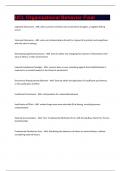UCL Organizational Behavior Final
Cognitive Dissonance - ANS when a person entertains two inconsistent thoughts, a negative feeling
occurs
Vicarious Dissonance - ANS when an individual places himself in a hypocrite's position and empathizes
with the other's feelings
Eliminating Cognitive Dissonance - ANS done by either one changing their opinion of themselves, their
view of others, or their environment
Induced Compliance Paradigm - ANS a person does or says something against their belief/attitude in
response to a coveted reward or the threat of punishment
Dissonance Shaping Human Behavior - ANS Done by either the application of insufficient punishment,
or the justification of effort
Insufficient Punishment - ANS mild penalties for undesirable behavior
Justification of Effort - ANS makes things seem more desirable (Frat Hazing, recruiting process,
compensation)
External Accuracy Bias's - ANS Four: Fundamental Attribution Error, Self-Serving Bias, Halo Error, Person
Sensitivity Bias
Fundamental Attribution Error - ANS Attributing the behaviors of others to internal factors, without
considering external factors
,Self-Serving Bias - ANS in others, we attribute failure to internal reasons and success to external
reasons. in ourselves, we do the opposite
Halo Error - ANS we tend to draw on a single characteristic when making wide-range evaluations of
individuals (looks, first impression, height, etc.)
Person Sensitivity Bias - ANS we tend to be more sensitive to the performance of individuals than we
are of teams (coach gets blame more than team, or one star team member gets credit)
Kelley's Theory of Casual Attribution - ANS behaviour gets attributed to causes based on circumstances
that appear at the time. The three attributes are: consensus, consistency, distinctivness
Consensus (Casual Attribution) - ANS the extent to which others behave similarly to the person. If
consensus is high (others similar), then high External reason for behaviour.
Consistency (Casual Attribution) - ANS the extent to which the person we are judging acts at other times
in same context. If consistency is low, then high External reason for behavior.
Distinctiveness (Casual Attribution) - ANS the extent to which the person does NOT act in the same way
in other contexts. If distinctiveness is high, then high External reason for behavior.
Personality - ANS both our social reputation and our inner nature. Relatively stable, and unchanging
over time.
Type Approach - ANS personality definition that includes A vs. B, Myers-Briggs (MBIT). Not as useful or
wide ranging, relys on bucketing.
Type A - ANS aggressive, achievement oriented, more heart attacks
, Type B - ANS relaxed, more deliberate behavior, more second heart attacks
Myers-Briggs Type Indicator (MBIT) - ANS personality type approach test that has 16 types (4 traits with
2 buckets each). Proved to be unreliable due to
Trait Approach - ANS defines personalities with more precision, not binary/bucketed,
NEO approach - ANS 5 broad factors of traits: Neuroticism, Extroversion, Openness, Agreeableness, and
Conscientiousness
Neuroticism - ANS ability to control and manage negative emotions, control impulses, cope with stress
(higher = worse)
Conscientiousness - ANS purposeful, strong-willed, and determined. Punctual, and reliable.
Achievement Striving - ANS aspect of conscientiousness, self-centered construct critical for the
advancement of managers (competition). Escalate commitment to failing projects.
Dutiful - ANS aspect of conscientiousness, more group success focused, critical for success of health
care professionals (and similar), more likely to de-escalate commitment to failing projects
Healthy Personality - ANS must exercise "core self-evaluation" and "emotional intelligence"
Motivation - ANS manifests in the "direction" behavior is focused, "level of effort" and "persistence of
effort"
Theory X - ANS motivation idea assuming that workers naturally dislike work, are lazy, and need
coercion to behave in motivating manner




